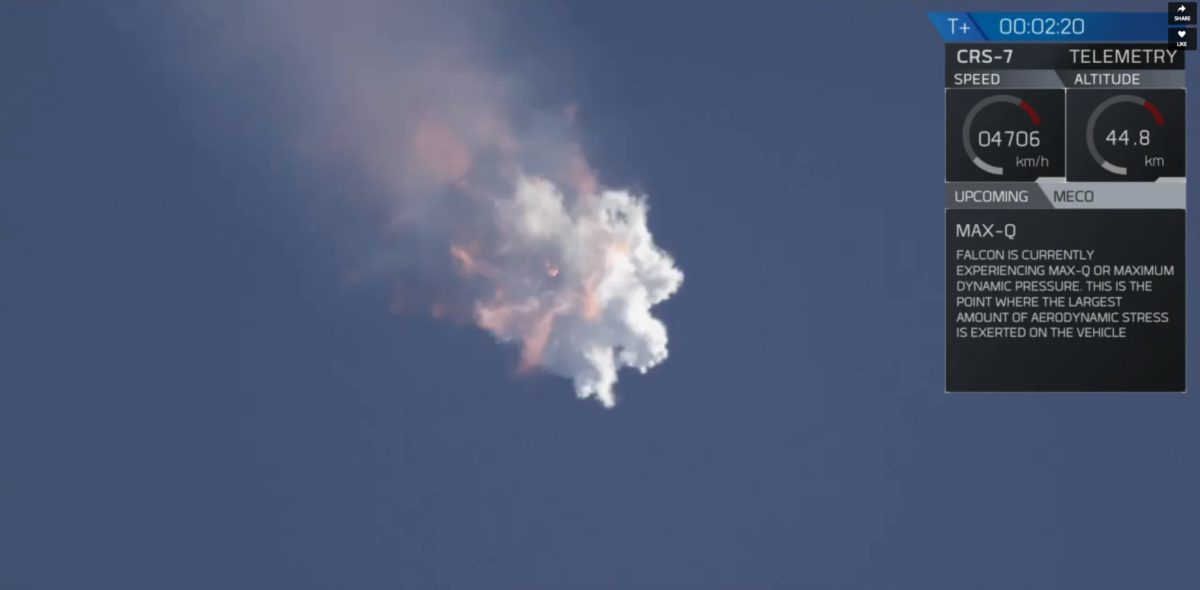Jason Davis • Jun 28, 2015
SpaceX Rocket Breaks Apart En Route to International Space Station
A SpaceX Falcon 9 rocket broke apart over the Atlantic Ocean today during the company's seventh paid cargo run to the International Space Station. Following a successful 10:21 a.m. EDT (14:21 UTC) liftoff, Falcon flew flawlessly for more than two minutes. But 139 seconds into the flight, a white cloud appeared near the rocket's second stage, and the vehicle disintegrated shortly thereafter.
SpaceX CRS-7 liftoff video (NASA TV) Video: NASA
"What I can tell you at this point is that first stage flight remained nominal," said Gwynne Shotwell, SpaceX’s president and chief operating officer. "We saw some pressurization indications in the second stage which we'll be tracking down. We did receive telemetry from Dragon after the event as well." Data readouts on the SpaceX web feed froze with the vehicle at an altitude of about 45 kilometers, traveling at more than 4,700 kilometers per hour.
There was an overpressure event in the upper stage liquid oxygen tank. Data suggests counterintuitive cause.
— Elon Musk (@elonmusk) June 28, 2015The vehicle experienced an anomaly on ascent. Team is investigating. Updates to come.
— SpaceX (@SpaceX) June 28, 2015The ISS-bound Dragon capsule was laden with 1.8 metric tons of crew supplies. William Gerstenmaier, NASA's associate administrator for the agency's human exploration division, said a spacesuit was among the items lost. Additionally, Dragon was carrying a new docking adapter in its unpressurized trunk, designed to allow future commercial crew vehicles to dock with the station.
"This is not really where I wanted to be on a Sunday afternoon," Gerstenmaier said, speaking to reporters during a post-launch press conference. "But spaceflight's not easy, as we've described to you before."
The loss of Dragon marks the third ISS resupply mission failure in just eight months. In October 2014, an Orbital ATK Antares rocket exploded shortly after liftoff. Six months later in April, a Russian Progress vehicle was left spinning out of control in orbit, doomed to an atmospheric reentry on May 7. "There's really no commonality across these three events," Gerstenmaier said, "other than the fact that it's space and it's difficult to go fly."
A mishap investigation will be conducted by SpaceX, with oversight provided by the Federal Aviation Administration. Since its debut in June 2010, the Falcon 9 has flown 18 times. Until today, the rocket's only major glitch came in 2012, when a secondary payload was lost due to a first stage engine failure. On that flight, the primary payload, another Dragon spacecraft, still made it safely to the ISS. Today's incident also delays SpaceX's efforts to recover the first stage of a Falcon 9 on an autonomous drone ship.
Despite the incident, both NASA and SpaceX fully expect to recover from the failure. A statement by NASA Administrator Charles Bolden said the crew has supplies to last several months. The next Progress vehicle is scheduled to launch July 3, and a Japanese HTV resupply ship is on deck for an August flight. "We expected through the commercial cargo program that we would lose some vehicles," Gerstenmaier said. "I didn't think we would lose them all in a one-year timeframe."
Support our core enterprises
Your support powers our mission to explore worlds, find life, and defend Earth. You make all the difference when you make a gift. Give today!
Donate

 Explore Worlds
Explore Worlds Find Life
Find Life Defend Earth
Defend Earth



